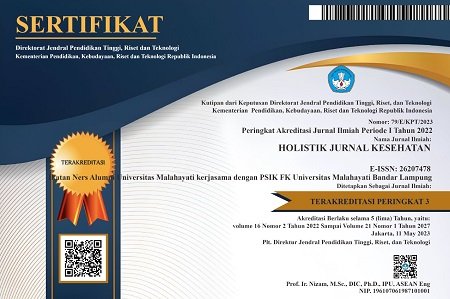PENDIDIKAN KEPERAWATAN BERKELANJUTAN MELALUI IMPLEMENTASI DISKUSI REFLEKSI KASUS (DRK): PILOT STUDY
Abstract
Keywords
Full Text:
PDFReferences
Bertero, C. (2010). Reflection in and on nursing practices-how nurses reflect and develop knowledge and skills during their nursing practice. International Journal of Caring Sciences, 3(3), 85–90.
Caldwell, L., & Grobbel, C. (2013). The Importance of Reflective Practice in Nursing. International Journal of Caring Sciences, 6(3), 319–326. Retrieved from http://internationaljournalofcaringsciences. org/ docs/4. us La.Caldwell.pdf.
Cleary, M., Horsfall, J., O’Hara-Aarons, M., Jackson, D., & Hunt, G. E. (2011a). The views of mental health nurses on continuing professional development. Journal of Clinical Nursing, 20(23–24), 3561–3566. http://doi.org/10.1111/j.1365-2702.2011.03745.x.
Cleary, M., Horsfall, J., O’Hara-Aarons, M., Jackson, D., & Hunt, G. E. (2011b). The views of mental health nurses on continuing professional development. Journal of Clinical Nursing, 20(23–24), 3561. Retrieved from http://search.proquest.com/docview/ 905715848? accountid=17242.
Covell, C. L. (2009). Outcomes Achieved From Organizational Investment in Nursing Continuing Professional Development. Journal of Nursing Administration, 39(10), 438–443.
Dalheim, A., Harthug, S., Nilsen, R. M., & Nortvedt, M. W. (2012). Factors influencing the development of evidence-based practice among nurses: a self-report survey. BMC Health Services Research, 12(1), 367. http://doi.org/10.1186/1472-6963-12-367.
Dolea, C., Stormont, L., & Braichet, J. M. (2010). Evaluated strategies to increase attraction and retention of health workers in remote and rural areas. Bull World Health Organ, 88(5), 379. http://doi.org/doi: 10.2471/BLT.09.070607.
Downs, S., Downs, S., Hospital, C., Service, H., Sunshine, T., & Private, C. (2013). Continuing professional development in nursing in Australia: Current awareness, practice and future directions, 45(1), 33–45.
Gibbs, G. (1988). Learning by doing: A guide to teaching and learning methods. Oxford: Oxford Further Education Unit.
Gould, D., Drey, N., & Berridge, E.-J. (2007). Nurses’ experiences of continuing professional development. Nurse Education Today, 27(6), 602–609. http://doi.org/10.1016/ j.nedt.2006.08.021.
Hallin, K., & Danielson, E. (2008). Registered Nurses’ perceptions of their work and professional development. Journal of Advanced Nursing, 61(1), 62–70. http://doi.org/10.1111/j.1365-2648.2007.04466.x.
Keputusan Menteri Kesehatan nomor 836 tahun 2005 tentang Pedoman Pengembangan Manajemen Kinerja Perawat dan Bidan.
Laaksonen, C., Paltta, H., von Schantz, M., Ylönen, M., & Soini, T. (2013). Journal club as a method for nurses and nursing students’ collaborative learning: A descriptive study. Health Science Journal, 7(3), 285–292.
Lachance, C. (2014). Nursing Journal Clubs: A Literature Review on the Effective Teaching Strategy for Continuing Education and Evidence-Based Practice. Journal of Continuing Education in Nursing, 45(12), 559–565. http://doi.org/10.3928/00220124-20141120-01.
Padma, P., Rajendran, C., & Sai, L. P. (2009). A conceptual framework of service quality in healthcare. Benchmarking: An International Journal, 16(2), 157–191. http://doi.org/10.1108/14635770910948213.
Popil, I. (2010). Promotion of critical thinking by using case studies as teaching method. Nurse Education Today, 31(2), 204–207. http://doi.org/10.1016/j.nedt.2010.06.002.
Ravin, C. R. (2012). Implementation of a journal club on adult learning and nursing professional development. Journal of Continuing Education in Nursing, 43(10), 451–5. http://doi.org/10.3928/00220124-20120702-16.
Mashiach Eizenberg, M. (2011). Implementation of evidence-based nursing practice: nurses’ personal and professional factors? Journal of Advanced Nursing, 67(1), 33–42. http://doi.org/10.1111/j.1365-2648.2010.05488.x.
Nursing and Midwifery Board of Australia. Continuing professional development (2016). Melbourne, Australia. Retrieved from http://www.nursingmidwiferyboard.gov.au.
PPNI. (2016). Pedoman pendidikan keperawatan berkelanjutan (PKB) perawat indonesia (Ed 2). Jakarta: DPP PPNI.
DOI: https://doi.org/10.33024/hjk.v11i4.155
Refbacks
- There are currently no refbacks.
Copyright (c) 2018 HOLISTIK JURNAL KESEHATAN

This work is licensed under a Creative Commons Attribution-NonCommercial 4.0 International License.














